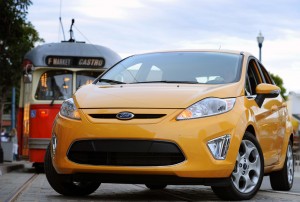
Though Ford isn't revealing details, sources suggest the 1.0-liter I3 engine may first show up on the Fiesta.
Ford will introduce another version of its high-mileage EcoBoost engine line-up, at 1.0-liter expected to be not just the smallest but the most fuel-efficient offering in its U.S. powertrain family.
Separately, the maker plans to match its competitors in the escalating “gear war,” with a new 8-speed automatic transmission now under development. Ford also plans to stop purchasing its hybrid drive system from outside supplier Aisin, bringing in-house the production of the advanced technology used in such models as the Ford Escape Hybrid and Lincoln MKZ Hybrid.
“We’re doing everything we can to improve fuel economy,” Derrick Kuzak, Ford’s global product development czar, told TheDetroitBureau.com prior to a Thursday news conference.
The new moves are “a significant development” for a company that had long been faulted for lagging behind on powertrain development, noted John McElroy, an industry analyst and host of the TV and webcast AutoLine: Detroit.
Work has been underway for several years on the 3-cylinder, 1.0-liter Ecoboost, which will join an expanding line-up of the turbocharged engines that are already offered in 4- and 6-cylinder configurations. But the timing couldn’t be better considering fuel prices are now nudging the previous records, set in July 2008, of $4.09 for a gallon of self-serve regular.
The challenge for Ford was to come up with a smooth and efficient engine that could match the performance of a more traditional 4-cylinder layout. To get there has required the development of some new approaches to small engine design, including an offset crankshaft, an exhaust manifold cast into the cylinder head, and a split cooling system that allows the cylinder block to warm up before the cylinder head, improving fuel economy.
As with earlier EcoBoost engines, the new 1.0-liter powertrain also uses turbocharging, direct injection and twin independent variable camshaft timing.
Calling the package “a little dynamo,” Kuzak suggested that despite delivering significantly better fuel economy, the 3-cylinder package will also yield the horsepower and torque of a normally aspirated 1.6-liter inline-four. Significantly, the cast manifold should offer improved performance at lower RPMs than the typical small engine.
Some of the new features, such as split cooling, may migrate to other Ford powertrains, hinted Joe Bakaj, vice president of global powertrain engineering.
“No one’s ever built a three-cylinder engine quite like this. Not only is it one of the most technically advanced and efficient engines we’ve ever designed, but it will introduce a number of new technologies to the Ford engine lineup,” said Bakaj.
While new engine designs can yield significant improvements in fuel economy – Ford claiming upwards of 10% to 20% for EcoBoost versus comparable engines – automotive engineers have also been looking into the opportunities afforded by more advanced gearboxes. Ford has begun introducing several new alternatives, including the so-called manumatic, or clutchless manual, offered in its little Fiesta. Meanwhile, it has been aggressively rolling out 6-speed automatics throughout much of its line-up.
Cutting edge just a few years ago, 6-speeds could soon become passé, it seems. Daimler-Benz, Audi, BMW, indeed most luxury makers, are migrating to 7- and 8-speed transmissions and the technology – which can yield fuel savings of 2% to 5% — are even going mainstream.
Chrysler has an 8-speed coming, and now Ford does, as well, the company revealed. Specific applications won’t be discussed until closer to the gearbox’s launch, though a source suggested the transmission would “make sense” in larger vehicles, such as various Lincoln models, the big Ford Taurus and possibly some crossovers and trucks, where mileage becomes a critical competitive issue.
“The new gearbox will be the first with a number of advanced new technologies that will provide faster, smoother and more positive shifts,” Bakaj said, pointing to a new input torque sensor that will not only speed up shifts but also reduce gear hunting on rolling roads or under heavy loads.
The third announcement from Ford concerns the maker’s hybrid drivetrain, which is currently produced by Aisin. The maker plans to make “a number of improvements,” according to Kuzak, and then shift production to its Van Dyke Transmission plant in suburban Detroit. The shift is expected to be completed in early 2012.
The newest version of the gas-electric driveline, now in use on the Ford Fusion Hybrid, can run in electric mode at speeds up to 47 mph and for up to one mile. While Ford declined to reveal specifics, the maker hinted the in-house update will deliver “improved performance over the current unit.”
The maker now offers a variety of conventional hybrids, such as the Fusion, Escape and MKZ, and it plans to launch five more advanced battery vehicles over the next two years, including a battery-electric Focus and a plug-in hybrid version of its upcoming C-Max microvan.
With still more battery vehicles likely to follow, “It’s absolutely essential for Ford to further develop its core competencies in engineering electrified powertrains,” Kuzak said.
